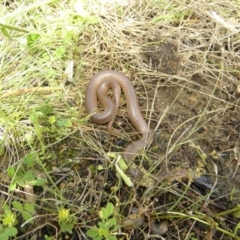1 Dwyer's Black-headed Snake at Wamboin, NSW
Identification history
| Parasuta dwyeri | 5 Jul 2017 | wombey | ||
| Parasuta dwyeri | 5 Jul 2017 | wombey | ||
| Parasuta flagellum | 1 Jul 2017 | Varanus |
Identify this sighting
Please Login or Register to identify this sighting.
User's notes
Located under a bucket that had been sitting for some time in a vegetable garden.
7 comments
wombey
wrote:
3 Jul 2017
I am less confident with this one as the images do not show a clear enough head shot. There seems to be black on the head where no black should be. Once again a mid body scale count would have been helpful. I stand corrected that this may be dwyeri ?
WillO
wrote:
3 Jul 2017
I agree with wombey - the body scale pattern and black head that includes the snout looks very like dwyeri. Good to get this record and the other one that was S. flagellum. well done.
Varanus
wrote:
3 Jul 2017
Thanks, John & Will. I went back to the original photo and expanded it fully. I accept your identification fully - it annoys me so greatly that for nearly 7 years I have had it entered into my collection misidentified. Still, I have identified two other sightings locally, one 500m west of me (the other Suta flagellum I submitted) and the other 2.300m SE of here which were both subsequently confirmed as correct by prof. herpetologists, so I know its around! Out come the roof tiles this year - I WILL find it!
WillO
wrote:
3 Jul 2017
Varanus I am interested to know approx how far your Little Whip Snake (flagellum) record is from open naturally grassy country. I have see this species at a few sites now (usually on granite or basalt) but at locations that were naturally treeless grasslands (near lake George and down on the Monaro). We have often wondered if the two species compete, with dwyeri keeping flagellum out of the drier hilly country. Also was your record on Ordivician sedimentary material (e.g. shale and mudstone)? This is really improving our understanding of the regional distribution of S. flagellum. Thanks WillO
Varanus
wrote:
4 Jul 2017
WillO - The site is situated on the Cullarin Block west of Weereewa (Lake George). There are two main soil landscapes in our area (Bywong and Macannally Mountain) according to Soil Landscapes of Canberra 1:100,000 sheet published by Land & Water Resources in 2000. Both are Ordovician meta-sediment areas, with similar vegetation types (open forest to woodland dependant on elevation). According to the current mapping of areas of pre-european native grasslands supplied by OEH some years ago, there are some smaller areas of grassland, one to the west, one to the east. and one to the south. The siting confirmed as Suta flagellum is 1.3km from the southern area, and 2.6km from the western area. However, this area was cleared from the 1930's through to the 1950's, and allowed to regenerate to local native grasses, with some small areas sown to Phalaris on creeksides and lower flat areas. This created open grassy areas through areas of former open forest where the animal may have been able to inhabit more easily. I hope this makes sense but am prepared to come in and meet with you to better explain the situation if you want, or you are welcome to see the sites out here for yourself. Rather than try to type it all out, you can ring me on 0427488845
wombey
wrote:
6 Jul 2017
Given WillO's comments I have taken the tentative step of changing this record to dwyeri.
Varanus
wrote:
6 Jul 2017
Wombey, it does not need to be tentative (see my comment above dated 2 July above). I fully agree with your and WillO's identification as Suta dwyeri. Cheers.
Please Login or Register to comment.
Nearby sightings
Location information
- Coordinates 149.331780-35.209860
- Altitude 840.0m
- Maps QPRC LGA
- Places Wamboin, NSW
Sighting information
- 1 Abundance
- 16 Nov 2010 01:51 PM Recorded on
- Varanus Recorded by
Species information
- Parasuta dwyeri Scientific name
- Dwyer's Black-headed Snake Common name
- Not Sensitive
- Local native
- Non-Invasive
- Up to 4294967279m Recorded at altitude
- Machine learning
- External link More information
-
Synonyms
Suta dwyeri Parasuta dwyeri Suta dwyeri
Record quality
- Images or audio
- More than one media file
- Confirmed by an expert moderator
- Nearby sighting(s) of same species
- GPS evidence of location
- Description
- Additional attributes







































































